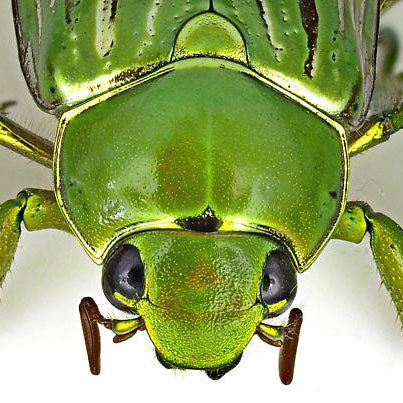Take a good look at this golden scarab beetle, Chrysina resplendens…
Probably the most ridiculously golden beetle ever, right? Now what if I told you that this beetle (and several other species of beetle in the family Scarabaeidae), actually shine brighter than they appear, the result of a light trick that only a few animals on the planet can accomplish? You’d be like “what!? Tell me more, especially if physics is involved, because I looooove long-winded physics explanations.” Ok great!
So what is this light trick? Hidden within the microstructure of the beetle’s exoskeleton there are helical twists and turns that enable certain species of scarabs the rare ability to create and reflect CIRCULARLY polarized light! Say what now? While many animals can create and even see LINEARLY polarized light, there are very few examples of the creation of circularly polarized light in nature, and Chrysina gloriosa, a particularly adorable species of scarab, is one of those special few:
Quite a derpy little chap! Hard to believe it can create one of nature’s rarest optical tricks. How do they DOOO itt??? Well, a light wave behaves like a beam of energy that can oscillate in many directions. Polarization is a property of waves that describes the direction of these oscillations (left, right, up, down), perpendicular to the direction of the wave. Pure white light is unpolarized, meaning that this light has oscillations in many directions. Light is said to be polarized when one of these directions of oscillation is removed or blocked, such as when a polaroid filter is used (thus blocking off either the up/down or left/right oscillations), or in the natural world, when light reflects off of surfaces, such as Chrysina gloriosa, whose helical exoskeleton microstructure creates the circular oscillation of light.
Circularly polarized light can travel in a left-handed or right-handed corkscrew. Looking at Chrysina gloriosa under a left-handed filter (so that only left handed oscillations pass through), it pops with luminescence! But under a right-handed filter (where only right-handed oscillations can pass), it turns totally dark! From this we can conclude that Chrysina gloriosa reflects only left-handed circularly polarized light.
So far only one animal on the planet has been proven to actually SEE circularly polarized light, the technocolor dream explosion that is the mantis shrimp:
But there aren’t a lot of mantis shrimps around in the juniper scrub habitat of Arizona where Chrysina gloriosa lives, so what is this extra shininess for? Perhaps, as scientists have hypothesiezed, Chrysina gloriosa can see circularly polarized light too, in which case these beetles would look even brighter and luminescent to each other than they do to us. This would give them a tremendous survival advantage by allowing the beetles to easily see and communicate with each other while simultaneously hiding from predators that cannot see circularly polarized light. While the jury is still out, scientists have gathered enough data that we can tentatively place Chrysina gloriosa (and perhaps other scarabs too), among the ranks of the circularly polarized light perception club, a truly elite club with a secret language all their own.
Further sciencey reading:
http://www.ncbi.nlm.nih.gov/pubmed/20302426
http://www.ncbi.nlm.nih.gov/pubmed/22155007
http://sites.sinauer.com/animalcommunication2e/chapter05.02.html
(Repost): Original Post: https://thebefuddledloris.wordpress.com/2013/05/15/crouching-predator-hidden-scarab/





